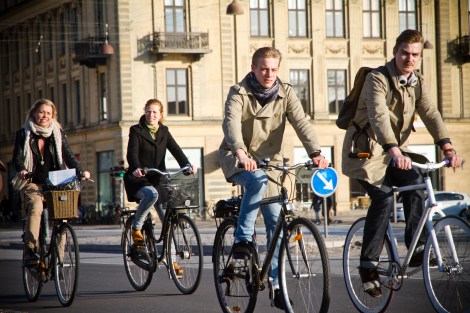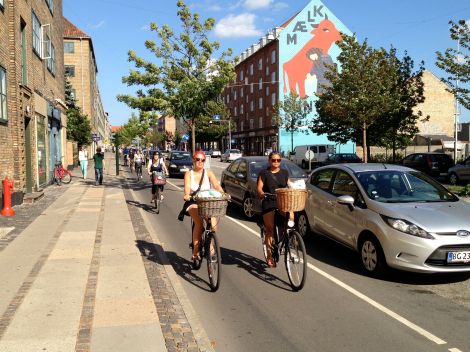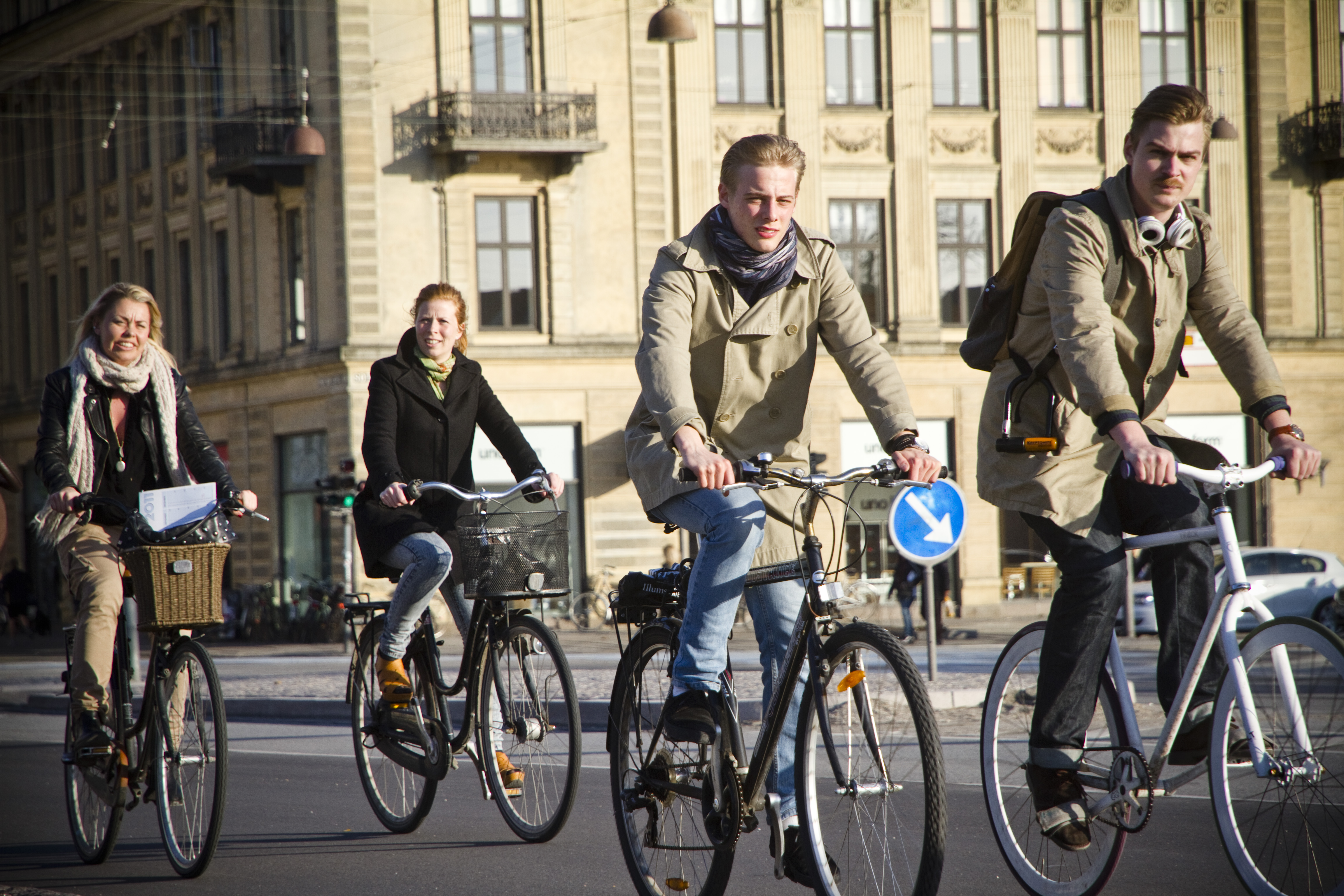
You cannot hope to be this stylish, ja?Copenhagenize Design Co.
This is the final piece of a short series about bicycles in Copenhagen. Read parts 1 and 2.
During my short trip to Denmark last month, I spent a good amount of time on a heavy, black cruiser bike rented from my hotel, exploring the city of Copenhagen and surrounds in search of lessons in bike culture, infrastructure, and policy that I could bring back home to the states. Some of my most productive time, however, was spent out of the saddle sitting at sidewalk cafés, talking to designers, planners, and policy wonks. Also, I spent loads of time drinking copious amounts of beer and/or coffee, and watching the beautiful people pedal by — most of them on “granny bikes” like mine.
I spent an entire afternoon at one café with Mikael Colville-Andersen, the CEO of Copenhagenize Design Co. Colville-Andersen makes a living as a provocateur and a preacher, spreading the gospel of biking to cities around the world. He makes a strong case that we should take our streets back from the traffic engineers, and instead design them with people in mind. He also says Americans need to take bicycling back from the bike tribes — the hipsters, speedsters, and bike messengers — and make them as ordinary as the black granny bikes on Copenhagen’s streets.
“Subcultures are actually a hindrance to building cycling,” Colville-Andersen said. “From an American perspective, I think you need to get the subcultures to shut up.”
I spent an hour on another afternoon drinking gypsy-brewed beer with Kasey Klimes, an urban data specialist with Gehl Architects, the firm that New York City Mayor Mike Bloomberg hired to help make his city more bike friendly. Klimes did a study on Queen Louise’s Bridge, one of Copenhagen’s main bike thoroughfares. After the city doubled the width of the bike tracks on the bridge and made other improvements, bike traffic increased by a third. Car traffic, meanwhile, dropped by half. Forty percent of those drivers found other routes, Klimes found, but 10 percent “just disappeared.” Apparently they decided that riding the bus or biking was a better option.
And in fact, when asked why they bike rather than drive, the great majority of Copenhageners respond that it’s simply the quickest, most convenient way to get around. Health and economic concerns are factors, too. Protecting the environment? Hardly a blip on their radar:
(Copenhagen city officials have worked hard to make biking easy. For details on their methods, which one planner described as “the carrot, the whip, and the tambourine,” check out part 2 in this series.)
On my last day in Copenhagen, I spent a few hours at yet another sidewalk café, talking with two fellow Americans who are working to get more people riding bicycles back home — and have some significant cash to throw at the problem, thanks to the enlightened self-interest of companies that make and sell bikes.
Zach Vanderkooy is the international programs officer for Bikes Belong, a Boulder, Colo.-based nonprofit that gets its funding from U.S. bicycle manufacturers, distributors, and retailers. Randy Neufeld is director of the SRAM Cycling Fund, a philanthropic arm of the company that makes Rock Shox and other bike components. Their main focus these days? Make American streets look more like the ones in Copenhagen.
Vanderkooy and Neufeld believe that there’s a large chunk of the American public that is poised and ready to bike. They cited work by Roger Geller, the bicycle coordinator for the city of Portland, Ore., who argues that fully 60 percent of the city’s population is curious about biking, but they don’t do it. Why? “It’s dangerous.”
Here’s a chart breaking Portland’s populace into the bikers, the non-bikers, and the yet-to-be convinced. If you want the thinking behind all this, Geller has written a whole report on the subject [PDF].
The key to moving people from the yellow “interested but concerned” zone to the green “enthused & confident” zone? Get rid of the fear factor, Vanderkooy and Neufeld said. That is, create a cityscape where they feel safe riding a bike. Traffic calming devices, neighborhood greenways, and bike trails all help, Neufeld said. “But the missing tool in the U.S. is protected bike lanes.”
By “protected,” he meant bike lanes that are separated from car traffic by more than a flimsy white line. Here’s how they do it in Copenhagen:

Greg Hanscom
They’ve put a line of car parking spaces — and an occasional tree — between the cyclists and the cars. It may seem like a small thing, but it makes an incredible difference. Rather than riding in constant fear of being clipped or flattened by a passing motorist, you’re free to tootle along, cigarette in one hand, cellphone in the other. (OK, don’t do that — but the Danes do.)
Cities from San Francisco to Washington, D.C., have installed protected or separated bike lanes in the past few years. Chicago Mayor Rahm Emanuel has vowed to install 100 miles of them during his four-year term. And Vanderkooy and Neufeld are hoping to make it spread further. Vanderkooy’s group, with funding from the SHRAM Cycling Fund, is sponsoring the Green Lane Project, a campaign that works with a half-dozen U.S. cities at a time to create protected bike lanes.
This is all fine and good, but I had to ask: Is biking in U.S. cities just a fad, fueled by a young generation that can’t afford cars?
Neufeld, a veteran bicycle activist who founded Chicago’s Active Transportation Alliance, doesn’t think so. He pointed to “megatrends” like a disinterest in driving among millennials, the decline in overall driving miles even as the recession has lifted, and the rising price of gasoline. Those trends are unlikely to turn around any time soon, he said. “None of this smacks as ‘fad’ to me.”
Instead, Neufeld thinks that we’re seeing an unprecedented opportunity to change American transportation culture for the better. “This is the big one,” he said. “There’s never been change at this pace. Bicycling has never been this popular.”
And for U.S. cities that have embraced bicycling in recent years, it’s not really about bikes, Vanderkooy said. “It’s about attracting young people and talent to your city. It’s about better economic performance, economic health, and public safety. Mayors have begun to embrace biking as purely a rational act, to make their cities competitive.”
With that, Neufeld looked at his watch, his eyes lighting up like a kid who woke up on Christmas morning and found a shiny new bike under the tree: “You guys want to go watch rush hour on the bridge?”
He was talking about Queen Louise’s Bridge, of course, that shining, squeaking emblem of Copenhagen’s rebirth as a bicycling city. And watch we did, joining the throngs of locals lining the railings.
I woke up at 3:30 the next morning, still discombobulated by the time change, and decided to go for a run. The sky was starting to get light as I ran past Queen Louise’s Bridge, and the crazy Copenhageners were still at it. Clusters of young people lined the sidewalks, cheering bicyclists as they pedaled past. One group had a portable sound system — in the front of a cargo bike, of course — and was throwing an impromptu dance party. Couples sat on the railing, looking east, waiting for the sunrise.
As the sun crested the skyline, a cheer went up, and the people on the bridge slowly collected their things, mounted their bikes, and started home. And so did I — I had an airplane to catch.




